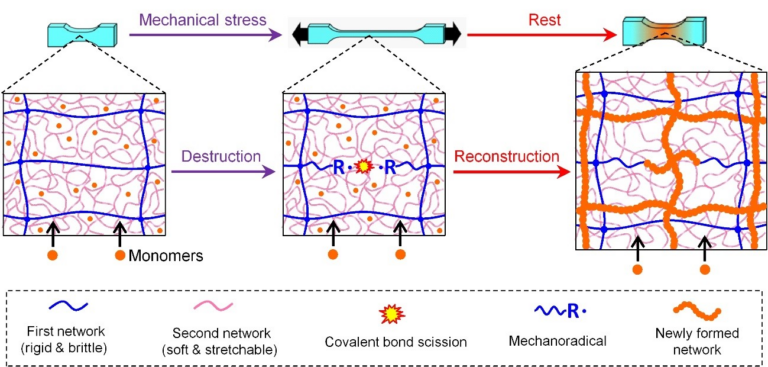A strategy inspired by the process responsible for muscle growth could lead to the development of stronger, longer-lasting materials
and also outlines the overall procedures and aims of the research.
(Copyright 2019, Hokkaido University)
We have developed a strategy to fabricate materials that grow in response to mechanical stress – mimicking skeletal muscle growth. Our findings could pave the way for long-lasting materials that can adapt and strengthen based on surrounding conditions.
The strategy was inspired by the process that makes human skeletal muscles become stronger. As a result of strength training at the gym, for example, muscle fibers break down, encouraging the formation of new, stronger fibers. For this to happen, the muscles must be supplied with amino acids, the building blocks of proteins, which join together and form muscle fibers.
We have developed a strategy employing ‘double-network hydrogels’ that emulates the building process of skeletal muscles.
We placed a double-network hydrogel inside a solution containing monomers, which can be joined to form polymers. This solution emulates the role of circulating blood carrying amino acids to skeletal muscles. Applying tensile force (stretching) to the hydrogel causes some of its rigid and brittle polymer chains to break. This leads to the generation of a chemical species called ‘mechanoradicals’ at the ends of the broken polymer chains. These mechanoradicals can trigger the joining up of the monomer absorbed into the hydrogel from the surrounding solution into a polymer network, strengthening the material.

With successive stretching, more breaking down and building up occurs, similar to what happens with skeletal muscles undergoing strength training. Through this process, the hydrogel’s strength and stiffness improved 1.5 and 23 times respectively, and the weight of the polymers increased by 86%.

Our work could help with the development of self-growing gel materials for applications as flexible exosuits for patients with skeletal injuries; these suits would potentially become stronger and more functional the more they are used. Since many types of DN gels have similar mechanical features, this process could be applied to a wide range of gels, expanding the range of potential applications.
References
- T. Matsuda, R. Kawakami, R. Namba, T. Nakajima, J.P. Gong, “Mechanoresponsive self-growing hydrogels inspired by muscle training,” Science, Vol. 363, Issue 6426, pp. 504+508, 2019.
Related News
-
Press release of our research was published on the Hokkaido University website
- Awards & Publications
-
Ms. Wei Gumi and Dr. Hang Yang got IGP 2023 Publications Award!
- Awards & Publications
-
Ms. Wei Gumi’s paper has been selected as 2024 Materials Horizons HOT article!
- Awards & Publications
-
[Press Releas] Self-growing materials that strengthen in response to force
- Research

